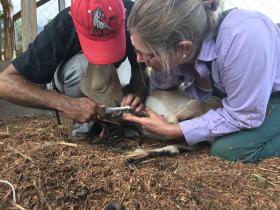
Learning to trim hooves and other adventures at Finca Ometepe
Welcome back to Finca Ometepe!
I have been abysmally poor about writing blogs but am going to try my best to write more regularly. I don’t want to forget any of the things I am learning, and I am learning so much! I think the best way to try to actually get up off my duff and write about more frequently is to not be too formal, but rather treat this blog as a way to tell my mother what I am doing. It takes the “scary” out of getting started. Let’s see how it goes and be sure to let me know what you think. Also, I am likely mostly going to write when I am actually at the farm, so the posts will come in fits and starts. My husband, Håkan, and I still live most of the year in Seattle, since we have not retired yet. We both have jobs, and our kids live in Seattle as well, so we are only actually in Nicaragua around 2 months a year right now but can’t wait until we can be here more.
There is so much to discover here at Finca Ometepe. Just yesterday I learned how to trim the goat’s hooves, the process of taking beans from the bush to the cup, and how to “clean” the plantains. In between all that, I milked the goat and made cheese, baked Oatcakes and Plantain Biscotti, went to the beach to swim and play in the waves (HUGE yesterday), and trained our new dog, Luna. Vacation just like I like it, busy and filled with learning!
I think I will start today by telling you about how to trim hooves on goats or other small ruminants.
Goats are members of the mammalian order Artiodactyla, all of whom have cloven hooves, which is what allows them to be able to dance like ballet stars on the rocks lying around our pastures. Their hooves grow constantly, just like our fingernails, and it does not hurt to trim them (unless you trim too deep). One needs to trim them so they stay healthy-if they get too long the overgrown wall (the outside part) can curl around and harbor moisture and filth, causing infection. They can also tear off accidentally, causing pain and lameness. Of course, wild goats wear theirs off naturally, but our goats walk mostly in the cushy pasture rather than scaling huge mountain cliffs, so they need regular care.
Although I am a veterinarian, I have never actually worked with small ruminants, just small animals and horses, so I called up my favorite farrier, Carlos, and asked him to come by and help me get started. A goat hoof is made of an outer wall, which is tough, and a softer inner sole. The white line separates the wall from the sole and is generally where the blood supply starts being present. The idea is to cut the wall of the hoof so that it is parallel with the coronary band, avoid cutting into the white line or sole so you don’t cause bleeding or pain, and avoid getting kicked in the eye. The goats, unfortunately, did not seem to enjoy their pedicures.
Since we don’t have a stanchion, I ended up lying them down on their sides for safety (theirs and ours). Believe it or not, the easiest way to control them with the least force was like this. When I showed this picture to my mother she said, in her typical dry Vermont humor, “I am glad they don’t have to sit on my head when I get a pedicure!”

